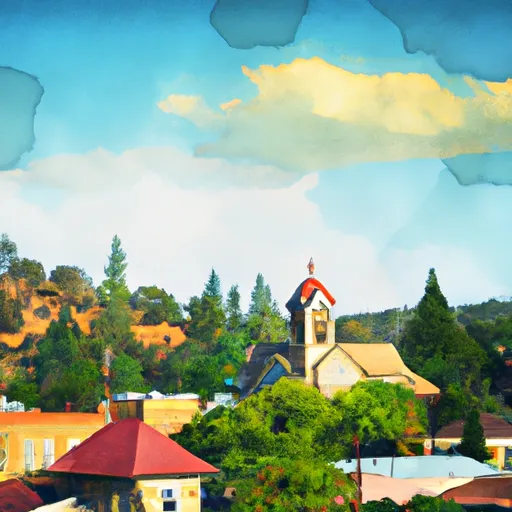-
 Snoflo Premium
Snoflo Premium
Get unlimited access to all our content
With no Ad interruptions! - Start Your Free Trial Login with existing account
Sutter-Creek
Eden Index
Climate
9.8
•
Recreation
4.6
•
Community
3.2
•
Safeguard
6.3/10

Sutter Creek, California is a charming historic town located in Amador County, nestled in the picturesque Sierra Nevada foothills. The town experiences a Mediterranean climate, characterized by hot, dry summers and mild, wet winters. Summers can see temperatures reaching the mid-90s°F (mid-30s°C), while winters are generally mild, with temperatures in the 40s°F (5-10°C). Spring and autumn offer pleasant weather, making them ideal seasons for outdoor activities.
Hydrologically, Sutter Creek is situated in the Mokelumne River watershed. The Mokelumne River provides a vital water source for the region, supporting diverse aquatic life and providing recreational opportunities such as fishing, kayaking, and rafting. The river's watershed also boasts numerous lakes, including Lake Pardee and Lake Camanche, which offer additional water-based activities.
Sutter Creek and its surrounding natural landscapes provide ample opportunities for outdoor recreation. The region is renowned for its scenic beauty and offers hiking, mountain biking, and horseback riding along its many trails. The area is also dotted with numerous vineyards and wineries, allowing visitors to indulge in wine tastings and tours. Overall, Sutter Creek is a delightful destination for nature enthusiasts, history buffs, and those seeking a relaxing getaway in a beautiful and temperate environment.
What is the Eden Index?
The Snoflo Eden Index serves as a comprehensive rating system for regions, evaluating their desirability through a holistic assessment of climate health, outdoor recreation opportunities, and natural disaster risk, acknowledging the profound impact of these factors on livability and well-being.
Climate Health Indicator (CHI): 9.8
Sutter-Creek receives approximately
809mm of rain per year,
with humidity levels near 75%
and air temperatures averaging around
16°C.
Sutter-Creek has a plant hardyness factor of
9, meaning
plants and agriculture in this region tend to thrive here all year round.
By considering the ideal temperature range, reliable water supplies, clean air, and stable seasonal rain or snowpacks, the Climate Health Indicator (CHI) underscores the significance of a healthy climate as the foundation for quality living.
A healthy climate is paramount for ensuring a high quality of life and livability in a region, fostering both physical well-being and environmental harmony. This can be characterized by ideal temperatures, reliable access to water supplies, clean air, and consistent seasonal rain or snowpacks.
Weather Forecast
Streamflow Conditions
San Joaquin
Area Rivers
San Joaquin
Snowpack Depths
San Joaquin
Reservoir Storage Capacity
San Joaquin
Groundwater Levels
Recreational Opportunity Index (ROI): 4.6
The Recreational Opportunity Index (ROI) recognizes the value of outdoor recreational options, such as parks, hiking trails, camping sites, and fishing spots, while acknowledging that climate plays a pivotal role in ensuring the comfort and consistency of these experiences.
Access to outdoor recreational opportunities, encompassing activities such as parks, hiking, camping, and fishing, is crucial for overall well-being, and the climate plays a pivotal role in enabling and enhancing these experiences, ensuring that individuals can engage in nature-based activities comfortably and consistently.
Camping Areas
| Campground | Campsites | Reservations | Toilets | Showers | Elevation |
|---|---|---|---|---|---|
| Acorn - New Hogan Lake | None | 699 ft | |||
| Indian Grinding Rock State Park | 22 | 2,378 ft | |||
| Finnon Lake | 14 | 2,427 ft | |||
| Oak Knoll - New Hogan Lake | None | 716 ft |
Nearby Fishing
Nearby Ski Areas
Catastrophe Safeguard Index (CSI):
The Catastrophe Safeguard Index (CSI) recognizes that natural disaster risk, encompassing floods, fires, hurricanes, and tornadoes, can drastically affect safety and the overall appeal of an area.
The level of natural disaster risk in a region significantly affects safety and the overall livability, with climate change amplifying these risks by potentially increasing the frequency and intensity of events like floods, fires, hurricanes, and tornadoes, thereby posing substantial challenges to community resilience and well-being.
Community Resilience Indicator (CRI): 3.2
The Community Resilience Indicator (CRI) recognizes that education, healthcare, and socioeconomics are crucial to the well-being of a region. The CRI acknowledges the profound impact of these elements on residents' overall quality of life. By evaluating educational resources, healthcare accessibility, and economic inclusivity, the index captures the essential aspects that contribute to a thriving community, fostering resident satisfaction, equity, and social cohesion.

